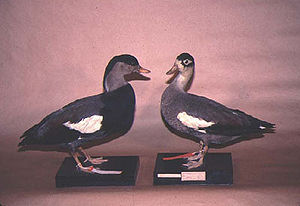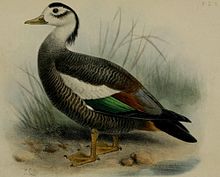Crested Kasarka
| Crested Kasarka | ||||||||||||
|---|---|---|---|---|---|---|---|---|---|---|---|---|

Crested Kasarka |
||||||||||||
| Systematics | ||||||||||||
|
||||||||||||
| Scientific name | ||||||||||||
| Tadorna cristata | ||||||||||||
| ( Kuroda , 1917) |
The crested shelduck ( Tadorna cristata ), also known as Korean Sheldrake or Hood Sheldrake referred to is probably a half goose extinct from the kind of shelduck. Their original home was the Amur region, northeast China, North and South Korea, possibly also the Japanese island of Hokkaido. Depictions of the crested kasarka in Japanese and Chinese painting suggest that the species was more common in the past and most likely was kept in human care as well. It is also mentioned in an ancient Japanese work on ornithology. From 1877 it became known in the western world and some scientists such. B. Philip Lutley Sclater assumed that it could be a hybrid of rusty goose and sickle duck . This theory was rejected as early as 1917 in the first scientific description by the Japanese ornithologist Nagamichi Kuroda ; however, it was never seriously pursued by crossbreeding.
features
The length was 58 cm, the wingspan 35 cm. The tail was approximately 11.7 cm long. They could be distinguished from the other Kasarka species mainly by their crest. The male had a green bonnet with a gray face and a black mask-like eye stripe, the female a black bonnet with a white face and a black band under the eyes. The plumage was metallic green with white underwings and black handwings. The male's back was gray, the female's gray-brown. The under tail covers showed an ocher yellow tone. The belly was dark brown with fine light brown diagonal lines. The beak and legs were colored flesh red. Nothing is known about the moulting process in this Kasarka species.
Nest building, eggs and clutches have not yet been scientifically described. Presumably the crested kazarka brooded in tree hollows, as do other kasarka species. Their habitat were mountain forests. She probably stayed there along rivers and streams, possibly also lakes. During the winter half-time it was observed near the estuaries and in coastal areas, so that migratory movements apparently took place in this species.
die out
The crested kasarka has probably been rare for the past 300 years. Between 1716 and 1736, some of these kasarkas were imported from Korea to Japan for breeding. Other birds were introduced to Japan for this purpose at least until 1854. However, there are no more offspring from these crested kasarcas kept in captivity.
In the years 1877, 1913 and 1916 the crested kazarcas were shot a total of three times. These specimens (two females and one male) are now in the museum collections of Copenhagen and Tokyo. On May 16, 1964, Russian students found three specimens (one male and two females) in the Primorye region (on the island of Bolshoi Pelis in Peter the Great Bay in the Sea of Japan near Vladivostok ) and sketched them. From the 1970s there were only a few unconfirmed reports of sightings (most recently in 1985). In the 1980s, the Chinese Forest Minister offered a prize to anyone who could provide evidence of the continued existence of this bird species. This action has so far been unsuccessful. If the species has survived, remnants of populations are likely to be found in the inaccessible region on the border between the People's Republic of China and North Korea . The IUCN lists the species as " critically endangered " . The causes of the decline are the destruction of their habitats and subsistence hunting.
literature
- David Day: The Doomsday Book of Animals. A unique Natural History of three Hundred vanished Species. Ebury Press, London 1981, ISBN 0-85223-183-0 .
- Errol Fuller : Extinct Birds. Oxford University Press, Oxford et al. 2000, ISBN 0-19-850837-9 .
- Janet Kear (Ed.): Ducks, Geese and Swans (= Bird Families of the World. Vol. 16, 1-2). Volume 1: General Chapters. Species Accounts (Anhima to Salvadorina). Oxford University Press, Oxford 2005, ISBN 0-19-861008-4 .
supporting documents
Individual evidence
- ↑ Kear: Ducks, Geese and Swans. Volume 1. 2005, p. 441.
- ↑ Kear: Ducks, Geese and Swans. Volume 1. 2005, p. 440.
Web links
- Birdlife factsheet (English)
- Crested Shelduck (English; PDF file; 507 kB)
- Tadorna cristata in the endangered Red List species the IUCN 2008. Posted by: BirdLife International, 2008. Accessed on October 10 of 2008.

